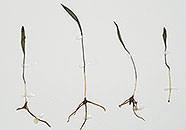Ophioglossum lusoafricanum Welw. ex Prantl
Synonyms |
Ophioglossum lancifolium sensu Burrows, pro parte |
|---|---|
Common name |
|
Description |
Rhizome elongated, up to 40 mm long, 1-3 mm wide, usually arising from a horizontal root; roots few, fleshy, sub-horizontal, proliferous; persistent leaf bases not present. Leaves 1 (sometimes 2), held at 60-90° from the horizontal. Petiole up to 9 cm long, subterranean for 30-50 % of its length, stipe:lamina lenght ratio 1-1.8:1. Sterile lamina (8-)21-48(-75) × (2-)3-8(12) mm, lenght:width ratio 3.3-8:8.1, narrowly elliptic or lanceolate in outline, apex pointed, base wedge-shaped to narrowly tapering, sometimes into a slender pseudo-petiole, venation obscure. Fertile segment 2-16 cm long, fertile spike:lamina lenght ratio 2.2-3:1, inserted at the base of the lamina or at the base of the pseudo-petiole. Sporangia 3-30 pairs. |
Notes | O. gracillimum, O. caroticaule and O. sandiae are, like O. lusoafricanum, narrow leaved Ophioglossum species. The leaf width:length ratio of these ferns differs : O. caroticaule 1:7.2, O. gracillimum 1:10-20, O. sandiae 1:4.5. O. lusoafricanum has a leaf width: length ratio of 1:7-9 and a slender, linear rhizome. |
Derivation | luso: Portuguese, africanum: of Africa: of Angola, a previously Portuguese colony, from where this fern was first collected. |
Habitat | Montane grassland, woodland, in marshy areas among tall grasses, in wet seepage soils, in shallow soils overlying sheetrock. |
Distribution worldwide | Africa, Madagascar. |
Distribution in Africa |
Angola, Ethiopia, Kenya, South Africa, Swaziland, Tanzania , Uganda, Zambia, Zimbabwe. |
Growth form |
Terrestrial. |
Literature |
|

